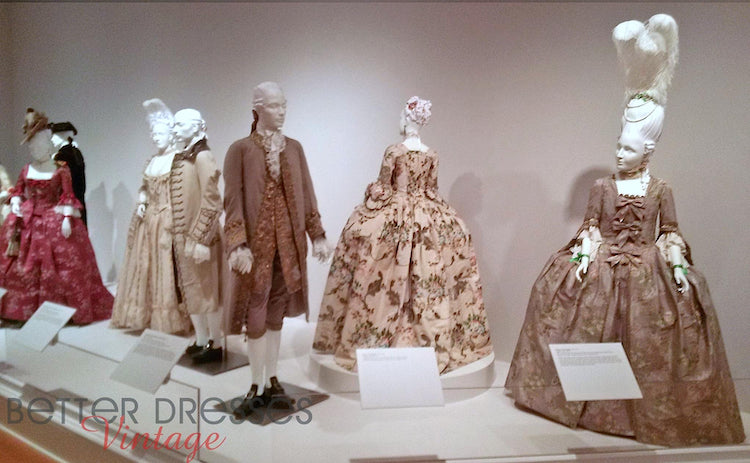
Exhibit Visit - "Fashionable Silhouettes" at the Mint Museum
Needing a break from routine, this past Saturday morning I hopped in the car, stuck a Book on Tape* in the player, and drove to North Carolina.
I'd recently learned that Charlotte's Mint Museum has an extensive and impressive historic costume collection, and with nothing of the sort here in Atlanta, it was the closest such destination.
Three-and-a-half hours later I arrived at the smaller of the Mint's two locations. Occupying an 1835 building that was once a branch of the U.S. mint (specializing in gold coinage), the Randolph site is nestled in a gorgeous park, in a lovely residential neighborhood. There's free parking just outside the door.


I paid the very reasonable $10 full-price entry fee and headed straight for the costumes. Yes, I'm sure the ceramics were lovely. But we know why I was there!

Who could blame me, right? There were few other visitors, however, and I could do my tiny-jumps-in-place-with-hands-flapping-in-excitement maneuver without attracting attention. I walked to the next room so I could start at the beginning.
The timeline moves, in mostly chronological order, from the 1740s to the 1920s. The bulk of the items are women's clothes, with a few interesting pieces of menswear thrown in. There are no children's garments currently on display.
There were also no peasant or working-class garments to be seen. Such items are rare (clothes that get constant, hard use are less likely to survive), and always interesting to see. But here you'll find only the highest-quality, au courant garments worn by the upper echelons of society -- whether guests of European royalty or of American politicians and industrial tycoons.
Here's where I began my visit, in 1745-50, with a Robe a la Française:

Note the panniers. Mid-18th century dresses were flat in front and back, but padding and small cage frames beneath the fabric created width at the hips. Some of these gowns reached such epic proportions, wearers had to turn sideways to pass through doorways (provided their towering hairstyles, adorned with everything from stuffed birds to sailing ships, would allow).
What struck me immediately was how very close I could get to the dresses! So. Very. Close.
There was one exception -- this "Robe à la Polonaise," displayed alone in a case. Experts disagree on the origin (and even the definition) of the style -- does it emulate traditional Polish dress or refer to the division of Poland into three sections at the time the style became popular? Either way, there is no doubt that this dress is a work of art:

And here's a closeup. See that rumpled bit of lace? Let's just say it's a good thing the dress was behind glass, or I may well have ended up in hand cuffs instead of at the gift shop:

My fuzzy photo shows the gown's decorative fly fringe. Click here to see how this knotted embellishment -- a popular pastime of 18th century society ladies -- is made. It looks like good fun if you're the crafty type! And a must-learn if you're a fan of historical costume.
Each hall contained a U-shaped display, and I read every word as I walked along, drooling. The first side of the first horse-shoe spanned 1745-90. Here are a few more images from that part of the timeline:
 (Note the daringly low neckline on the Robe à l'Anglaise at right.)
(Note the daringly low neckline on the Robe à l'Anglaise at right.)
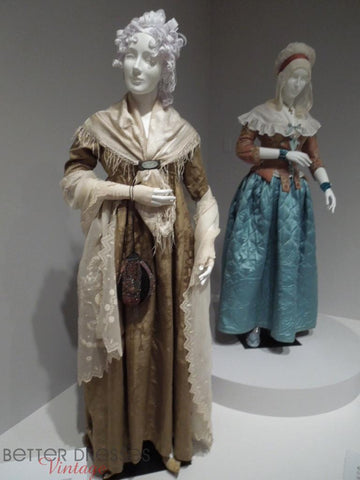 (A "round gown" c. 1790 left, and a jacket and petticoat -- which at the
(A "round gown" c. 1790 left, and a jacket and petticoat -- which at the
time referred to a skirt, not an undergarment -- c. 1780, right.)
A round gown is a simpler, softer-looking, one-piece dress with a closed (not split at the front) skirt and slightly raised waist. This late 18th century style foreshadows the popular Empire silhouette to come.
 (Round gown detail. Note the fingerless gloves and Wedgwood jasper brooch.)
(Round gown detail. Note the fingerless gloves and Wedgwood jasper brooch.)
I was surprised to learn that fingerless gloves, known as mitts, had been fashionable as long ago as the 1700s. I'd always thought of them as modern -- mid-century, at the oldest. Wrong.
Curving around to the second arm of the horseshoe brought me to the years 1800-1850.
This group illustrates the radically new silhouette of Empire style. Dresses now featured a very high waist and open neckline with a soft, straight skirt. Inspired by ancient Greece and Rome, the changes went beyond fashion, influencing every aspect of art and architecture. This classical revival was also known as Biedermeier (Germany), Federal (U.S.), or Regency (U.K.). Fans of Jane Austen novels (or perhaps movie adaptations) will be instantly familiar.

Look at the difference between my perfectly reasonable size US7 (UK5, Euro38) shoe and the impossibly slim c. 1810-20 shoe. I look like Sasquatch in comparison!

By the 1830s, skirts had once again grown full. Here's a lovely c. 1836-40 ball gown with crocheted Bertha (collar). Note the dress's ankle length:

It took heavy layers of petticoats to fill out these early 19th-century skirts. That changed with the invention of a stiff, horsehair (that's crin in French, get it?) petticoat in the 1840s. And by the 1850s, new steel cage crinolines let skirts reach widths not seen since the mid-1700s.

I'm thinking I will recreate the above look for my next attempt at the Sunday in the Park Victorian Costume Contest. What do you think?
Around the corner in the next room lay my favorite era -- the late 1800s! I could barely contain myself.
Here's the first thing I found fascinating. No, not the dress, the duffle bag! The sign told me it and the dress are c. 1860s, but that linen-and-wool bag, which I very much wanted to lift from the mannequin's hand and take home with me, looked as if she picked it up at Anthropologie. Why the gift shop doesn't reproduce and sell these items is beyond me.

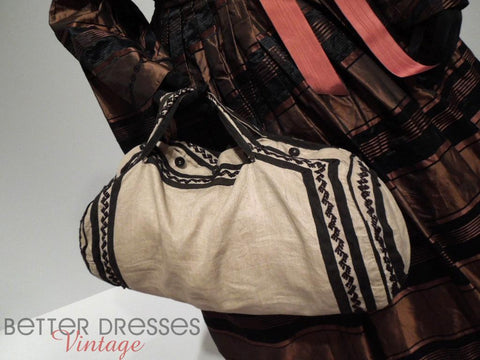


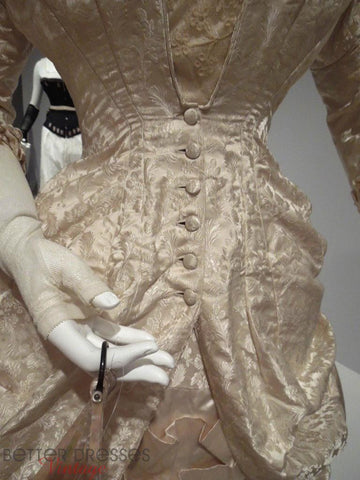
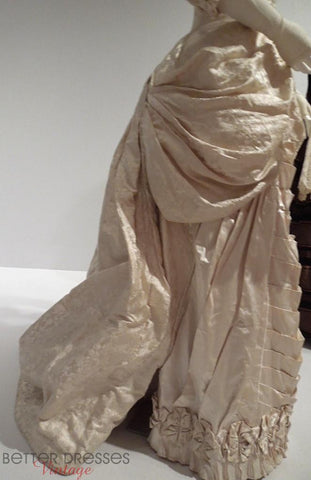
A few more of the gorgeous, richly detailed and colorful dresses from the late 1870-80s:


The lush purple ensemble behind me featured a matching muff:


Rounding the final corner, we remain in the Gilded Age/Belle Epoque as we near the 20th century. For me, the most notable item among the Worth and Doucet gowns was this lovely black silk organza and chantilly lace hand fan with jet beads, c. 1890-1900 (note the continued popularity of mitts, this pair c. 1890-1900):

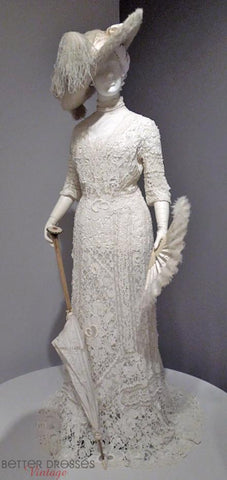

Next to catch my eye was this couple, dressed for afternoon social visits c. 1895-99. Isn't her tiny box purse adorable? And how interesting that the gentleman's shoes, c. 1890-95, could have come right out of my husband's closet. They look thoroughly modern to me. A far cry from the heeled and buckled brocade numbers on display in the adjacent hall:



The current exhibit hardly mentions the pigeon bodice/S-curve silhouette of the early Edwardian era, moving straight into the straighter, smoother lines created by newly elongated corsets. Can't you picture Lady Cora wearing something quite similar to this c. 1911 gown in Season 1 of Downton Abbey, set just 1 year later?

Finally, exhausted but ridiculously happy, I arrived in the 1920s, where two iconic dresses are presented. The first features the familiar drop-waisted, straight silhouette of the flapper. Check out that incredible hat, and (displayed with the other dress) my favorite shoes of the entire exhibit:


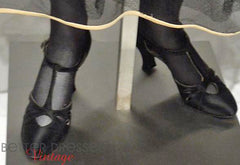
The very last dress brings us full circle, showcasing the brief return in the mid-1920s of the pannier silhouette from the mid-1740s (now called a Robe de Style). What a clever and satisfying ending to the timeline:

The "Fashionable Silhouettes" exhibit reveals just a tiny portion of the Mint Museum's 10,000-piece permanent costume collection. I am hopeful that the offerings are changed on a regular basis, as I'd happily make an annual pilgrimage to see what other glorious items might be on display. Won't you join me?



Wall-mounted cases held accessories corresponding to each hall's decades. Here are a few of my favorites:
 (Visitation Calendar and Pencil c. 1885, ivory and sterling silver,
(Visitation Calendar and Pencil c. 1885, ivory and sterling silver,
forerunner of the Day Runner, Palm Pilot, and Samsung Note, perhaps?)
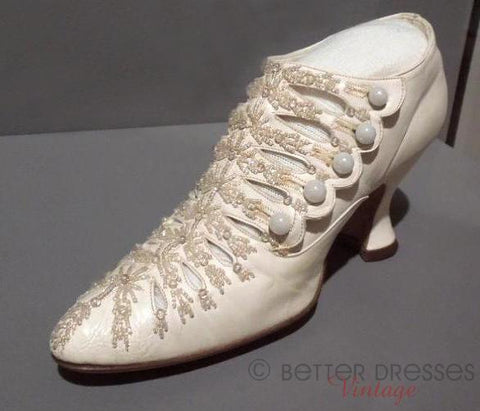 (Wedding Shoe c. 1914, kidskin with glass beads and buttons)
(Wedding Shoe c. 1914, kidskin with glass beads and buttons)
 (Spectator Shoe c. 1910-20, leather and suede)
(Spectator Shoe c. 1910-20, leather and suede)

* On CD, of course, they're no longer on tape. The book was "Gardens of Water," a novel by Alan Drew, and I enthusiastically recommend it. The story follows the lives of two families -- one Kurdish, one American -- in Turkey just before and after the earthquake of 1999. Bring your hankie.

Comments
Spectacular exhibit! Thank you for sharing your incredible visit to the Mint Museum. What a treat!!!
Wonderful report, Liza….and, I will join you for your annual pilgrimage! Just let me know when you want to go!
Thanks for the tip. I ll have to make that a trip for sure..
